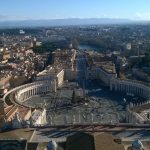150 YEARS OF THE NAZARETH SISTERS
In the footsteps of Blessed Frances Siedliska in Rome (6)
Sr. M. Beata Rudzińska, CSFN

Prisoner of the Vatican
The pontificate of Pius IX, the pope who blessed Francisca for founding a new religious family, was the longest in the history of the Church (almost 32 years) and was marked by many difficult events. Pius IX was rather never on good terms with Italian patriots and revolutionaries. During the Spring of Nations, he did not support their demands, which resulted in his being declared a traitor and forced to flee Rome disguised as an ordinary priest. He returned in 1850 with the help of French troops. Also, his lack of support for the idea of Italian unification was most likely the reason that 130 years after these events his beatification (September 3, 2003) was not attended by state officials. But what Pius IX considered his failure, the loss of the Church State, actually became the source of his success. He had already proclaimed the dogma of the Immaculate Conception, convened Vatican Council I, and contributed to the growth of local churches, especially in America. After 1870, aware of his political failure, he became even more of what the successor of St. Peter should be, and by his heroic life he initiated a new era of saints and blessed popes. He showed that it was possible to lead the Church without owning land, an army and earthly power, something that had seemed impossible before. Freed from this ballast, he turned all his energies to strengthening the inner life of the Mystical Body of Christ.
However, such an assessment of the situation as we have from the perspective of 150 years, neither Frances nor her contemporaries had. In protest of the manifest injustice, Pius IX and his successors did not leave the Vatican for almost 60 years, did not appear at St. Peter’s Square or even give a public blessing, in order to avoid any appearance of accepting the new power in Rome. The faithful from various countries organized pilgrimages to Rome to express their solidarity with the Pope. Frances’ reaction was no different. Her almost “innate” love for the Church and the successors of St. Peter found even more reason for the main task of the new Congregation to be ” offering prayers, work, sufferings and the entire being for the Holy Father and the Holy Catholic Church” . Such are the words we find in her request to Pius IX.
Although the Italians never entered the Vatican territory demarcated by the Leonian Walls and sought a compromise with the Pope, unfortunately on their own terms, the so-called Roman question was only resolved by Benito Mussolini’s fascist government, seeking the support of the Papacy. In 1929, the Lateran Treaties were signed, separating the Vatican state territorially and politically and recognizing its independence.
The treaties were completed symbolically and propagandistically by Mussolini’s delineation of a new route connecting Rome to the Vatican, namely via della Conciliazione (literally: Street of Reconciliation). This one of the world’s most famous streets was unfortunately created by displacing nearly 5,000 people and demolishing, in less than a year, the Spina del Borgo district with its many medieval buildings. This is not the first and not the last such controversial decision by Rome’s new administrators. But more about that at another time…
Pictures:
Pius IX (1875) – Public domain
The last days of Spina del Borgo – www.tripadvisor.com
Spina del Borgo during demolition (1937) – Public domain
Current view on via della Conciliazione – Sr. Anita Jach




